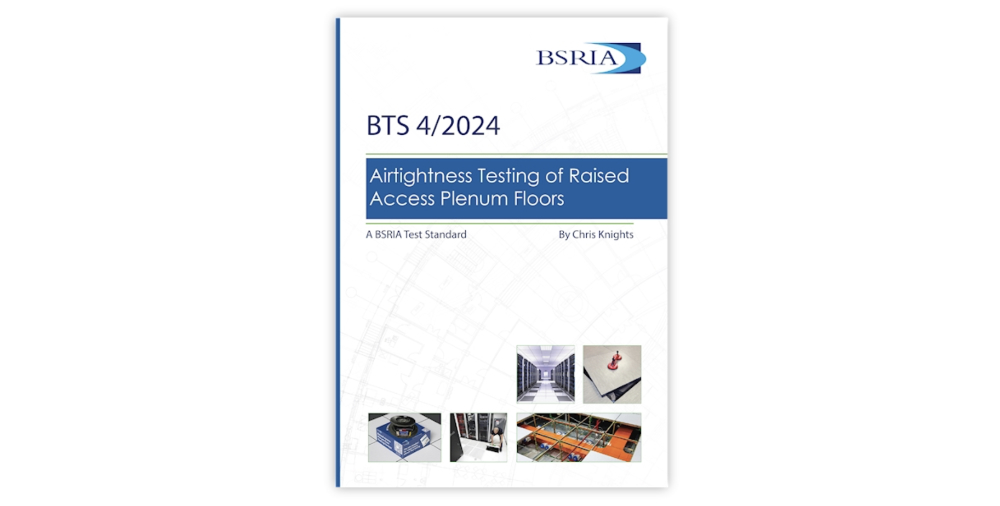Airtightness Testing of Raised Access Plenum Floors (BTS 4/2024)
A raised access plenum floor is a void between a building’s floor structure and the occupied space. This BSRIA Test Standard provides a methodology for testing raised access plenum floors and states limiting criteria for leakage. It supersedes BG 65/2016 Floor Plenum Airtightness – Guidance and Testing Methodology.
In response to stakeholder feedback to enhance and simplify the guide, BG 65/2016 Floor Plenum Airtightness – Guidance and Testing Methodology was superseded in 2024 by a new BSRIA Test Standard.
A raised access plenum floor is a void between a building’s floor structure and the occupied space, used for distributing conditioned air to the spaces above, consisting of two elements; the underfloor void and raised access floor. It is important that conditioned air in a floor plenum flows into the occupied zone and does not leak into cavities, risers, stairwells, heating trenches or other adjacent zones. A properly sealed raised access plenum floor will allow the diffusers and grilles to fulfil their primary role of delivering air at the correct flow rate. The airtightness of raised access plenum floors can be a serious energy efficiency issue.
This BSRIA Test Standard provides a methodology for testing raised access plenum floors. Limiting criteria for leakage from the underfloor void and raised access floor are provided, tailored to the challenges of smaller floor areas. Guidance on achieving both is provided. The testing methodology has also been enhanced to offer a complete process, eliminating the need to consult additional standards.
Specifying BTS 4/2024 can support an effective air distribution solution that aligns with design intentions for operational performance.
Revision History:
- Withdrawn: BG 12/2010 Floor Void Airtightness – Air Leakage Specification
- Superseded: BG 65/2016 Floor Plenum Airtightness – Guidance and Testing Methodology
- Current: BTS 4/2024 Airtightness Testing of Raised Access Plenum Floors
This article appears on the BSRIA news / blog and bookshop site as 'Airtightness Testing of Raised Access Plenum Floors (BTS 4/2024)' dated 01 December, 2024.
--BSRIA
[edit] Related articles on designing Buildings
- Airbrick.
- BSRIA articles.
- Displacement ventilation.
- Dynamic thermal modelling of closed loop geothermal heat pump systems.
- Earth-to-air heat exchangers.
- Floating floor
- Floating floors in buildings..
- Geothermal energy.
- Geothermal pile foundations.
- Ground energy options
- Ground preconditioning of supply air.
- Ground source heat pumps.
- Plenum.
- Raised floor.
- Thermal comfort.
- Thermal labyrinths.
- Underfloor air conditioning at London Grade II listed landmark.
- Underfloor air distribution UFAD.
Featured articles and news
Grenfell Tower Principal Contractor Award notice
Tower repair and maintenance contractor announced as demolition contractor.
Passivhaus social homes benefit from heat pump service
Sixteen new homes designed and built to achieve Passivhaus constructed in Dumfries & Galloway.
CABE Publishes Results of 2025 Building Control Survey
Concern over lack of understanding of how roles have changed since the introduction of the BSA 2022.
British Architectural Sculpture 1851-1951
A rich heritage of decorative and figurative sculpture. Book review.
A programme to tackle the lack of diversity.
Independent Building Control review panel
Five members of the newly established, Grenfell Tower Inquiry recommended, panel appointed.
Welsh Recharging Electrical Skills Charter progresses
ECA progressing on the ‘asks’ of the Recharging Electrical Skills Charter at the Senedd in Wales.
A brief history from 1890s to 2020s.
CIOB and CORBON combine forces
To elevate professional standards in Nigeria’s construction industry.
Amendment to the GB Energy Bill welcomed by ECA
Move prevents nationally-owned energy company from investing in solar panels produced by modern slavery.
Gregor Harvie argues that AI is state-sanctioned theft of IP.
Heat pumps, vehicle chargers and heating appliances must be sold with smart functionality.
Experimental AI housing target help for councils
Experimental AI could help councils meet housing targets by digitising records.
New-style degrees set for reformed ARB accreditation
Following the ARB Tomorrow's Architects competency outcomes for Architects.
BSRIA Occupant Wellbeing survey BOW
Occupant satisfaction and wellbeing tool inc. physical environment, indoor facilities, functionality and accessibility.
Preserving, waterproofing and decorating buildings.
























